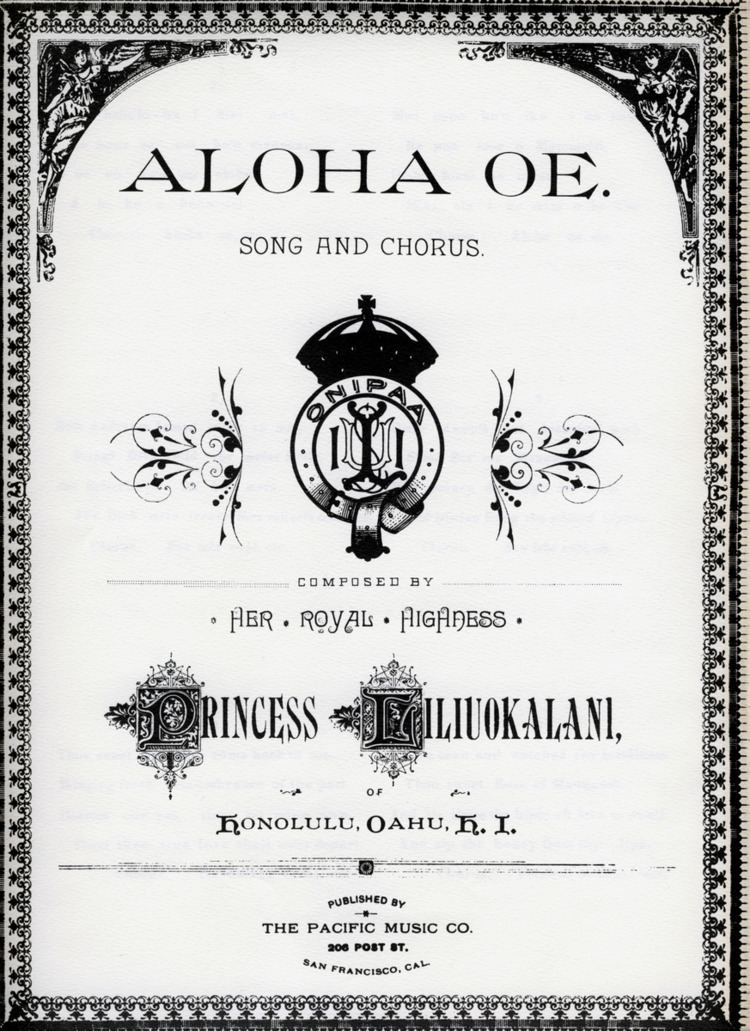 | ||
"Aloha ʻOe" (Farewell to Thee) is Liliʻuokalani's most famous song and a common cultural symbol for Hawaii. The story of the origin of the song has several variations. They all have in common that the song was inspired by a notable farewell embrace given by Colonel James Harbottle Boyd during a horseback trip taken by Princess Liliʻuokalani in 1877 or 1878 to the Boyd ranch in Maunawili on the windward side of Oʻahu, and that the members of the party hummed the tune on the way back to Honolulu. Different versions tell of alternate recipients of the embrace — either Liliʻuokalani's sister Princess Likelike Cleghorn or a young lady at the ranch. According to the most familiar version of the story:
Contents
This tender farewell set Liliʻuokalani to thinking, and she began humming to herself on the homeward trip. Overhearing, Charles Wilson observed, "That sounds like The Lone Rock by the Sea," a comment with which Liliʻuokalani is said to have agreed. When the party paused to rest in an orange grove on the Honolulu side of the Pali, the others joined in the hummings, and the song was completed later at Washington Place.
The Hawaiʻi State Archives preserves a hand-written manuscript by Liliʻuokalani, dated 1878, with the score of the song, the lyrics, Liliʻuokalani's English translation, and her note evidently added later: "Composed at Maunawili 1878. Played by the Royal Hawaiian Band in San Francisco August 1883 and became very popular." A 1913 score can be seen at the Levy Sheet Music Collection.
Musicology
The song "The Lone Rock by the Sea", recalled by Charles Wilson as "The Rock Beside the Sea" and published by Charles Crozat Converse in 1857, derives from a Croatian folk song, "Sidi Mara Na Kamen Studencu" ("Girl on the Rock").
Musicologist Sigmund Spaeth noted that the first two measures of the melody of the chorus (which are arpeggiated IV-I chords) resemble the chorus of George Frederick Root's 1854 song "There's Music in the Air," but measures 3 and 4 differ from it.
The same melodic motif begins the chorus of the popular song "Open Up Your Heart (And Let the Sunshine In)" (1954).
In popular culture
In the Disney film Lilo & Stitch (2002), the song is sung briefly by the character Nani Pelekai (voiced by Tia Carrere) as a means to say goodbye to her sister Lilo, as they were going to be separated from each other by then. It is sung again in its franchise's fourth film Leroy & Stitch (2006) by Lilo (Daveigh Chase), Stitch (Chris Sanders), and Reuben (Rob Paulsen) to shut down the Leroy clones. The song also appears on the soundtrack of Lilo & Stitch 2: Stitch Has a Glitch (2005).
The song also plays in many episodes of SpongeBob SquarePants, albeit in instrumental form.
"Aloha 'Oe" appeared in the scores of many of Warner Bros.' classic Looney Tunes and Merrie Melodies cartoons, as composer Carl Stalling's stock musical cue for Hawaii-themed gags. Usually instrumental, but Bugs Bunny actually sings one line of the refrain at the very end of Case of the Missing Hare. Also, in the 1953 cartoon short, Duck Amuck part of it is briefly sung by Daffy Duck when the scenery is changed to a Hawaiian setting, courtesy of a sadistic mystery animator.
In the Japanese anime Space Dandy (created in 2014), the eponymous main character is captain of a spaceship called the Aloha Oe.
The Jack London short story Aloha Oe features the chorus of the song.
When Jiang Zemin, then-Chinese President and the General Secretary of the Communist Party of China, arrived at Hawaii at the beginning of his state visit to U.S. in October 1997, he played "Aloha ‘Oe" with a Hawaiian lap steel guitar and invited then Hawaiian First Lady Vicky Cayetano to sing the song at a dinner with the presence of Governor Ben Cayetano. Jiang recounted that he used to frequently play this song when he was in college in 1940s.
This song is also partially sung in the movie Train to Busan by one of the main character, which also happens to be essential to the ending of the movie.
